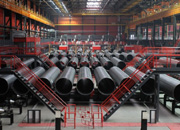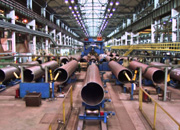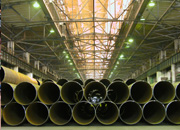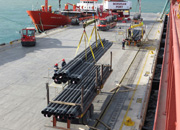Cutting
12Cr1MoV seamless steel pipe is indeed a technical job, especially for this kind of high-strength, high-temperature-resistant alloy steel. If you are not careful, cracks, burrs, and even tool wear may occur. Today, we will teach you how to complete cutting efficiently and safely from three perspectives: tool selection, operation skills, and common problems!
First, understand the relevant pain points.
- High material hardness: 12Cr1MoV contains chromium, molybdenum, and vanadium, and ordinary saw blades are prone to chipping;
- Easy to produce thermal cracks: High temperature during cutting may cause local embrittlement of steel;
- High incision requirements: In industrial scenarios, it is often necessary to keep the incision flat to avoid subsequent welding or turning troubles.
Second, tool selection: matching materials is the key
Recommended solution:
- Plasma cutting machine: suitable for fast cutting of thick-walled seamless steel pipes (>10mm), the cut is relatively smooth, but attention should be paid to ventilation (the smoke contains chromium compounds);
- Grinding wheel cutting machine: economical and practical, choose special alloy steel cutting blades (marked "Cr-Mo steel special"), the speed is recommended to be below 3000rpm;
- Laser cutting: the highest precision, but high cost, suitable for batch processing of thin-walled seamless steel pipes.
Tips for avoiding pits: ordinary tungsten carbide saw blades are prone to heat and deformation, it is recommended to choose cobalt-based alloy saw blades (such as M42 material), as the durability is increased by more than 3 times.
Third, operation steps: details determine success or failure
Take grinding wheel cutting as an example:
1. Fix the steel pipe: double fix with V-shaped clamp + rubber pad to avoid rolling (scratching the surface);
2. Mark + pre-cut: use a scriber to mark accurately, and first lightly cut a 2mm deep guide groove;
3. Push at a uniform speed: apply pressure evenly with both hands and stop the knife immediately when you hear a harsh sound;
4. Cooling treatment: spray coolant every 30 seconds of cutting (can be replaced by water-soluble cutting fluid).
Advanced skills: It is recommended to cut thick-walled seamless steel pipes in sections (cut 1/3 depth-first, rotate 120°, and then cut) to reduce heat concentration.
Fourth, first aid guide for common problems
- Many burrs: use a file to trim the edges in one direction at 45°, and never rub back and forth;
- The cut is blue: it means overheating, reduce the speed or increase the cooling frequency next time;
- The saw blade is stuck: turn off the power immediately, and tap the side of the saw blade in the opposite direction to release the stress.
Finally, a reminder: After cutting, remember to use magnetic particle inspection to check the edge of the cut. Hidden cracks are difficult to detect with the naked eye! If it is a pressure-bearing pipe, be sure to anneal it to eliminate stress.
 Threeway Steel is known as a professional supplier engaged in manufacturing and distributing a wide range of steel pipe, and our headquarter located the central part of China – Hunan and six associated factories throughout China.
Threeway Steel is known as a professional supplier engaged in manufacturing and distributing a wide range of steel pipe, and our headquarter located the central part of China – Hunan and six associated factories throughout China.
 Threeway Steel is known as a professional supplier engaged in designing, manufacturing and distribution of a wide range of steel products with the headquarter located the central part of China – Hunan and six associated factories throughout China.
Threeway Steel is known as a professional supplier engaged in designing, manufacturing and distribution of a wide range of steel products with the headquarter located the central part of China – Hunan and six associated factories throughout China.
 Threeway Steel is known as a professional supplier engaged in designing, manufacturing and distribution of a wide range of steel products with the headquarter located the central part of China – Hunan and six associated factories throughout China.
Threeway Steel is known as a professional supplier engaged in designing, manufacturing and distribution of a wide range of steel products with the headquarter located the central part of China – Hunan and six associated factories throughout China.
 Threeway Steel is known as a professional supplier engaged in designing, manufacturing and distribution of a wide range of steel products with the headquarter located the central part of China – Hunan and six associated factories throughout China.
Threeway Steel is known as a professional supplier engaged in designing, manufacturing and distribution of a wide range of steel products with the headquarter located the central part of China – Hunan and six associated factories throughout China.
 Threeway Steel is known as a professional supplier engaged in designing, manufacturing and distribution of a wide range of steel products with the headquarter located the central part of China – Hunan and six associated factories throughout China.
Threeway Steel is known as a professional supplier engaged in designing, manufacturing and distribution of a wide range of steel products with the headquarter located the central part of China – Hunan and six associated factories throughout China.

